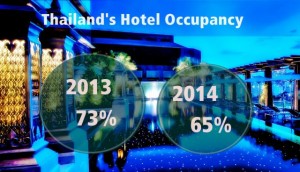The hotel industry had a very rough year in 2014, and despite the fact that its last quarter started to bring positive results, the overall state all hotel industry in Thailand was far from a good one last year. According to data coming straight from the hotels, the year over year occupancy rate was lowered with 11.3%, which is very concerning. The main occupancy drop affected mostly hotels in the capital, whom saw a decline of more than 16%. In fact, for the first half of the year the city occupancy was lower than 20%.
Phuket fared a little better, with a 5.7% drop, and it actually to fare better than the numbers achieved in 2011. When it comes to Koh Samui, the city actually fared better than most in Thailand, with a small decrease of just around 1.6%.
The resurgence of Q4 for all Thailand hotel industry
A recovery for the whole hotel industry began in the last part of the third quarter, but only in the last quarter of 2014 things actually started to head towards the right direction for the hotel industry in Thailand. The revenue per room started go grow with 2.5%, which is a good increase in the year over year number. In fact, the occupancy rate for December in Bangkok was one of the highest since 2000, with this being the best quarter since 2006. This happened in the whole country though, and not only its capital. According to these numbers, it seems that it takes around 6-9 months for the hotel industry to get back to better numbers, according to Jesper Palmqvist, the director of STR Global for the Asia and Pacific region.
Uncertain rates
According to the industry numbers, the daily rate has increased with 2.6%, showing once more that the capital does have the financial resources to sustain any crisis. Sure, there were hotels with substantial losses, but the end of 2014 caught ADR with a flat situation. However, the resorts markets did have to take some interesting choices, with regions such as Koh Samui having higher rates in the season with low demand as well. This is why we were able to see a drastic decrease in rate movement, despite the region offering a lot more seasonal variety than others, like Phuket for example. The latter region had higher numbers each year, and it had a sustained response over and over again, despite issues such as floods for example.
RevPAR: resorts had better results
A good market was Chiang Mai, which despite the decrease of 4.2%, it had a positive ADR movement which is definitely a stunning thing to say the least, if you take into consideration that the region had solid, growing numbers for a long time now. In addition to that, Hua Hin managed to hold its rates quite well, although Pattaya did suffer a large loss of more than 10% when it comes to its year over year occupancy rates.
All in all, the Thailand hotel industry did manage to fare better and better in the past few months, which clearly shows that the industry did recover with flying colours from the issues!






